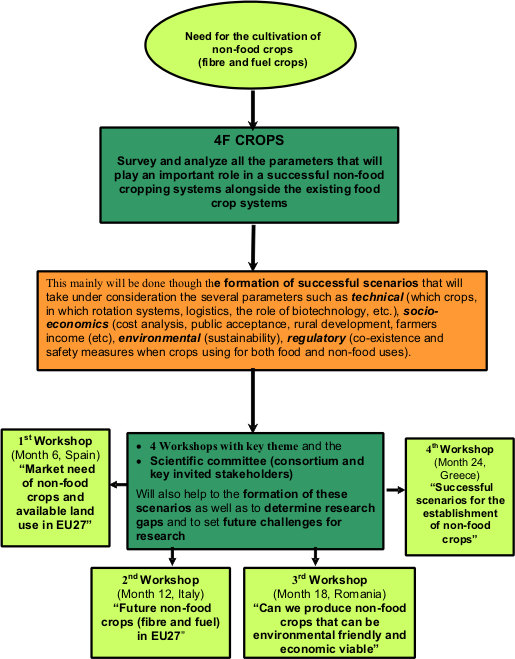The concept
|
The ultimate scope of the project will be achieved through the following specific objectives: • Review of the agricultural land uses in EU27 and the prediction in short (2020) and longer terms (2030), so as to identify possibilities for non-food cropping systems for each time frame. Four tasks have been designed in WP1 (Land Use in EU27).The first task will survey the current land use in EU27 (Task 1.1), in the second task the restrict factors for the EU agriculture will be identified and the market needs for non-food crops (energy production and bio-based products) will be evaluated. In the last task of WP1 the key factors that will determine the Land Use in 2020 and 2030 will be evaluated and thus the possibilities for non-food cropping systems will be recorded. • Mapping of cropping possibilities like choice of crops, rotation cycles, yielding potential, raw material characteristics for each end-use based on regional potential levels, ecology and climate This specific objective will be met through the six tasks of WP, where a bulk of valuable and relevant information will be collected from previous and on-going EU and national projects. Information will refer to the choice of crops for each end-use, their yielding potential and raw material characteristics, their growing rotation cycles rotation cycles. It should be pointed out that the role of the biotechnology improvement that will expect to play in the non-food crops will be investigated and recorded (Non Genetic Modification). Cropping possibilities of the non-food crops in EU27 agriculture will be conducted in the last task of WP2. • Comparative cost analysis of the food and non-food crops in short and long term consideration and evaluation of the most critical socio-economic parameters, like farmer's income, rural development, public acceptance and safety measures The WP3 (Economic analysis and socio-economic impacts) has been designed to cover the above-mentioned objective by means of four tasks. The first three tasks are devoted to the development and adaptation of the existing models, to the economic analysis of the non-food crops and finally to the comparison between the food and the non-food crops. The last task has been designed to record and evaluate the social impacts of further establishment of non-food crops (farmer's income, rural development, public acceptance and safety measures from the co-existence of food and non-food crops). • Evaluation of the most important environmental criteria (soil, water, air, climate change, biodiversity, landscape) by means of an Environmental Impact Assessment (EIA) and a Life Cycle Analysis (LCA) The evaluation of the most important criteria through an Environmental Impact Assessment and Life Cycle Analysis will be done in WP4 and in the last task of WP4 the best options will be identified. It should be noted that the food crops systems have in most of the cases negative environmental impacts such as soil erosion, nitrates to the soil, needs for irrigation water, reduction of biodiversity, etc. • Record of the existing policies and the driving forces in the future crops Without driving forces non-food cropping systems will be very difficult to establish. Through WP5 the existing policies will be recorded in a national context and will be critically evaluated. Emerging best practices and the key factors that led to the success stories will be pointed out. Barriers that prevented the development of bob-food cropping systems will be analyzed and reviewed. In addition co-existence and safety measures when crops as used for both food and non-food uses will be addressed and recommendations will be sought. A framework of strategic policies options will be formed (WP5). • Development of scenarios for promising non-food cropping alongside food cropping systems, by defining systems' boundaries and evaluating the priorities and trends, in short and long time frameworks. The development of the scenarios for the successful establishment of the non-food crops systems will be carried in WP6. First of all the results obtained from the WPs 1 to 5 will be integrated and evaluated and then the system boundaries be will defined and the framework conditions will drawn up and then finally the priorities will be evaluated and the scenarios for the successful establishment will be formatted. • To develop a whole dissemination plan that its main elements will be the web-site development, the projects workshops and other dissemination activities (articles, presentations, fact sheets, leaflets, links with previous and on-going activities, etc.) Since the project is coordination and support action aimed at coordinating research activities the dissemination of the findings of the project is a key action with high importance (WP7). For this reason dissemination plan will be drawn up at the outset of the project. The main elements of the dissemination plan will be: the development of the 4F CROPS web-site, the organisation of the projects workshops, presentation to projects results in European and International Conferences, articles to conferences/journals, fact sheets for the most promising non-food crops, leaflets, etc. The whole dissemination plan will be run through three tasks: development of the project web site, projects workshops and other dissemination activities.
|
